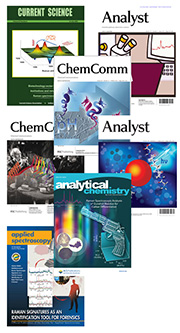Research Projects
Forensic Analysis of Body Fluids Using Vibrational Spectroscopy |
||
Lednev’s laboratory has developed a universal method for nondestructive, automatic, confirmatory identification for all main body fluids based on Raman microspectroscopy and advanced statistics. It was also demonstrated that the method allows for differentiating human and animal blood that is important for investigation of hit-and-run cases. Dry traces of menstrual and peripheral blood can be also differentiated. A regression model for estimating the time-since-deposition of blood up to two years that is essential for determining the time of crime and/or selecting bloodstains relevant to the crime. Most recently, the developed methodology was further expanded for phenotype profiling based on dry tares of body fluids: sex, race and age of the donor can be determined. When fully developed, this method will be invaluable for the law enforcement agencies. To commercialize the new patented methodology Dr. Lednev has started-up a company SupreMEtric LLC (www.supremetric.com) and received Phase I NSF STTR grant. |
||


